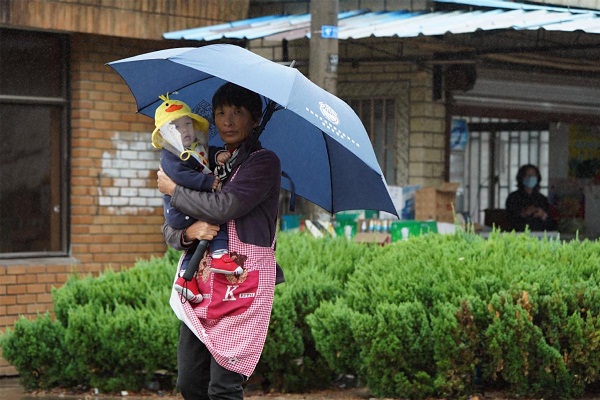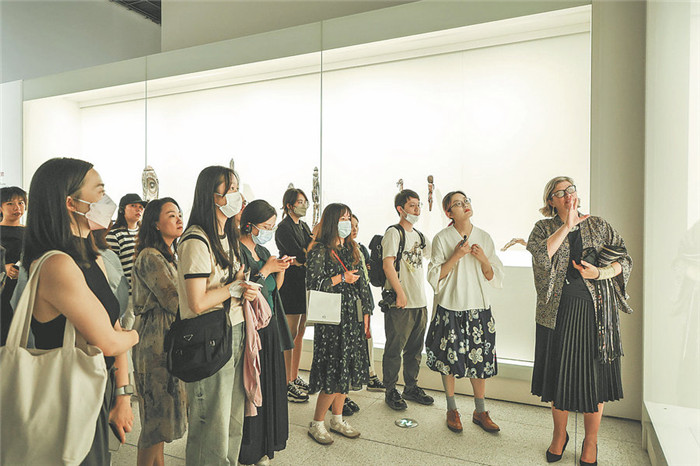Shanghai keeps one step ahead of virus

A resident and her grandchild shelter from the rain at the village. GAO ERQIANG/CHINA DAILY
Prompt action taken after new cases reported
Ma Jie, Party secretary of Yingqian village in Shanghai's Pudong district, can finally catch up on some well-earned sleep after dozing on the floor of the village office for 14 consecutive nights.
A lockdown was imposed in the village, which has a population of 3,000, after a local COVID-19 case was reported on Nov 9. The restrictions were lifted on Tuesday after residents completed 14 days of quarantine.
Yingqian was removed from the list of areas at medium risk of spreading the disease after there were no reports of secondary infection during the quarantine period.
The action taken in the village epitomizes how Shanghai, which aims to become one of the world's safest cities for public health by 2025, has mobilized its resources to counter the contagion.
Ma said, "The villagers showed a high degree of cooperation, and more than 100 volunteers, security guards and police officers went the extra mile to communicate, patrol and help in various ways during the lockdown."
Shanghai confirmed six local cases in the past week and a total of seven this month. Five imported cases were reported among cargo workers at Shanghai Pudong International Airport. Two of the workers' wives were also infected.
Leading local health expert Zhang Wenhong said Shanghai's epidemic prevention and control efforts have helped keep the city one step ahead of the virus. These efforts include the rapid deployment of resources, a quick response and precise preventive measures.
Zhang, head of Shanghai's COVID-19 clinical expert team, said, "The city is still under threat, as new infections are being reported and the risk of scattered cases may linger throughout the winter as the pandemic evolves. However, we're confident that life will be close to normal, thanks to the efforts of the government and residents regarding personal protection."
On Nov 9, nucleic acid testing for the residents of Yingqian village started at 9 am and ended at midnight.
Chu Fuguo, a 60-year-old resident who acted as a volunteer during the lockdown, said, "Most people cooperated, even though we knocked on some doors late at night to make inquiries."
The villagers, who took the tests on the first, sixth and 13th days of the quarantine period, all returned negative results.
Ma said a contingency plan, which included setting up a temporary quarantine site and sending in designated ambulances, was drawn up in case anyone tested positive.
Despite no such results being reported, ambulances were still sent to the village a number of times during the 14 days. They took residents, who under the quarantine regulations could not go to hospitals by themselves, to medical institutions for various reasons, including the birth of a baby and treatment for accidental cuts.
On the second day of the lockdown, when a villager was due to give birth, Ma said he contacted the hospital in advance to ensure that pandemic prevention measures were in place. The expectant mother was admitted that evening and her baby was born the following day.
Yin Xiuping, a 51-year-old resident, said she and her family spent most of their time at home and complied with the request not to gather with neighbors.
"We have witnessed the great efforts made by government workers and healthcare professionals for the village and for ourselves, which included the provision of food once every two days. We, as individuals who care for this city, want to make our contribution to safeguard it," she said.
Thousands tested
On Monday, video clips of nucleic acid tests being administered to more than 17,700 cargo workers at Pudong International Airport the previous night went viral.
The tests involved 240 doctors and nurses and 300 workers who helped with preparatory work.
Netizen Xin Zhidu said, "The tests were like a meticulous blanket search for a suspicious infection. We're confident the city, which has a government that people trust, will make it through. Stay strong Shanghai and the world!" The comment received 27,000 "likes".
Epidemiologists said the infections among the airport workers are a reminder that imported non-cold-chain cargo may become a viral transmission route in winter.
Zhou Junlong, vice-president of the Shanghai Airport Authority, said strict cargo disinfection, standard loading and unloading procedures and protection for key workers will be strengthened at cargo handling facilities.
Pan Hao, deputy head of Shanghai's front-line COVID-19 work team, said epidemiological investigation tracing for the cases reported in the past week was expanded from close contacts, and those linked to them, to individuals at the same work site or in the same occupation.
A case reported on Monday was discovered among the nucleic acid test results for the airport cargo workers.
The prompt action taken by the Shanghai authorities has again been impressive. City and district centers for disease control and prevention, or CDCs, have thoroughly screened, located and quarantined individuals related to the latest cases, with their work being clearly defined.
For example, after two cases were reported on Nov 20, the city's CDC said the next day that 91 close contacts, 213 people linked to these close contacts and 15,415 other individuals had been traced. Their initial nucleic acid test results were obtained, and most of those involved were quarantined at designated hotels, while the remainder made their way to quarantine locations.
Pan said that when the medical team members failed to identify the source of infection for the case reported on Nov 9, involving a cargo worker at the airport, they felt frustrated.
Strenuous efforts were made to detect the source through human-to-human or object-to-human transmission vectors-the two channels commonly agreed on internationally.
Pan said, "We later began to look for possible work sites that the two cases (on Nov 20) had been exposed to. We finally identified an aircraft container from North America, which the workers entered without wearing face masks on Oct 30.
"Tests also showed the virus they were infected with was a strain from North America," he said.
Experts said the early detection of infections in the past week also showed that Shanghai's network of 117 fever clinics, where an intelligent system to report suspicious cases has been installed, had played its part.
Wu Jinglei, director of the Shanghai Municipal Health Commission, said, "The system collects and analyzes information concerning cases, helps health authorities and CDCs to predict epidemic development more accurately and enables effective precautionary measures to be taken promptly."
 Contact Us
Contact Us

 New pedestrian street boosts Pudong's night economy
New pedestrian street boosts Pudong's night economy  Festival injects vitality into Shanghai's consumer market
Festival injects vitality into Shanghai's consumer market A journey through history
A journey through history Chinese roses bloom in Pudong
Chinese roses bloom in Pudong


